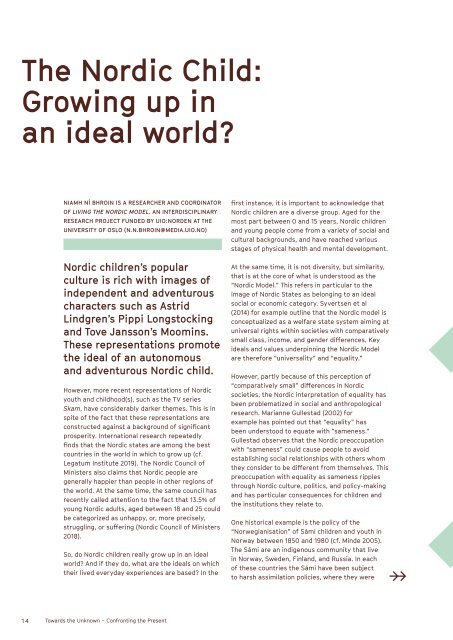ASSITEJ Magazine 2019
This is the annual ASSITEJ magazine, launched during the ASSITEJ Artistic Gathering 2019 in Kristiansand (Norway). It contains high-quality articles on theatre for young audiences from all corners of the world!
This is the annual ASSITEJ magazine, launched during the ASSITEJ Artistic Gathering 2019 in Kristiansand (Norway). It contains high-quality articles on theatre for young audiences from all corners of the world!
You also want an ePaper? Increase the reach of your titles
YUMPU automatically turns print PDFs into web optimized ePapers that Google loves.
The Nordic Child:<br />
Growing up in<br />
an ideal world?<br />
NIAMH NÍ BHROIN IS A RESEARCHER AND COORDINATOR<br />
OF LIVING THE NORDIC MODEL, AN INTERDISCIPLINARY<br />
RESEARCH PROJECT FUNDED BY UIO:NORDEN AT THE<br />
UNIVERSITY OF OSLO (N.N.BHROIN@MEDIA.UIO.NO)<br />
Nordic children’s popular<br />
culture is rich with images of<br />
independent and adventurous<br />
characters such as Astrid<br />
Lindgren’s Pippi Longstocking<br />
and Tove Jansson’s Moomins.<br />
These representations promote<br />
the ideal of an autonomous<br />
and adventurous Nordic child.<br />
However, more recent representations of Nordic<br />
youth and childhood(s), such as the TV series<br />
Skam, have considerably darker themes. This is in<br />
spite of the fact that these representations are<br />
constructed against a background of significant<br />
prosperity. International research repeatedly<br />
finds that the Nordic states are among the best<br />
countries in the world in which to grow up (cf.<br />
Legatum Institute <strong>2019</strong>). The Nordic Council of<br />
Ministers also claims that Nordic people are<br />
generally happier than people in other regions of<br />
the world. At the same time, the same council has<br />
recently called attention to the fact that 13.5% of<br />
young Nordic adults, aged between 18 and 25 could<br />
be categorized as unhappy, or, more precisely,<br />
struggling, or suffering (Nordic Council of Ministers<br />
2018).<br />
So, do Nordic children really grow up in an ideal<br />
world? And if they do, what are the ideals on which<br />
their lived everyday experiences are based? In the<br />
first instance, it is important to acknowledge that<br />
Nordic children are a diverse group. Aged for the<br />
most part between 0 and 15 years, Nordic children<br />
and young people come from a variety of social and<br />
cultural backgrounds, and have reached various<br />
stages of physical health and mental development.<br />
At the same time, it is not diversity, but similarity,<br />
that is at the core of what is understood as the<br />
“Nordic Model.” This refers in particular to the<br />
image of Nordic States as belonging to an ideal<br />
social or economic category. Syvertsen et al<br />
(2014) for example outline that the Nordic model is<br />
conceptualized as a welfare state system aiming at<br />
universal rights within societies with comparatively<br />
small class, income, and gender differences. Key<br />
ideals and values underpinning the Nordic Model<br />
are therefore “universality” and “equality.”<br />
However, partly because of this perception of<br />
“comparatively small” differences in Nordic<br />
societies, the Nordic interpretation of equality has<br />
been problematized in social and anthropological<br />
research. Marianne Gullestad (2002) for<br />
example has pointed out that “equality” has<br />
been understood to equate with ”sameness.”<br />
Gullestad observes that the Nordic preoccupation<br />
with “sameness” could cause people to avoid<br />
establishing social relationships with others whom<br />
they consider to be different from themselves. This<br />
preoccupation with equality as sameness ripples<br />
through Nordic culture, politics, and policy-making<br />
and has particular consequences for children and<br />
the institutions they relate to.<br />
One historical example is the policy of the<br />
“Norwegianisation” of Sámi children and youth in<br />
Norway between 1850 and 1980 (cf. Minde 2005).<br />
The Sámi are an indigenous community that live<br />
in Norway, Sweden, Finland, and Russia. In each<br />
of these countries the Sámi have been subject<br />
to harsh assimilation policies, where they were<br />
14 Towards the Unknown – Confronting the Present



